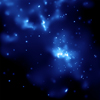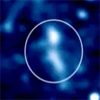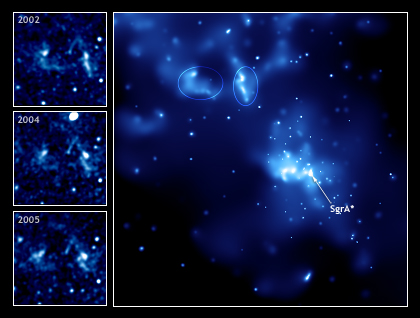Chandra Discovers Light Echo from the Milky Way's Black Hole
This set of Chandra images shows evidence for a light echo generated by the Milky Way's supermassive black hole, a.k.a. Sagittarius A* (pronounced "A-star"). Astronomers believe a mass equivalent to the planet Mercury was devoured by the black hole about 50 years earlier, causing an X-ray outburst which then reflected off gas clouds near Sagittarius A*.
The large image shows a Chandra view of the middle of the Milky Way, with Sagittarius A* labeled. The smaller images show close-ups of the region marked with ellipses. Clear changes in the shapes and brightness of the gas clouds are seen between the 3 different observations in 2002, 2004 and 2005. This behavior agrees with theoretical predictions for a light echo produced by Sagittarius A* and helps rule out other interpretations.
While the primary X-rays from the outburst would have reached Earth about 50 years ago, before X-ray observatories were in place to see it, the reflected X-rays took a longer path and arrived in time to be recorded by Chandra.
The clouds of gas featured in the image are glowing by a process called fluorescence. Iron in these clouds has been bombarded either by X-rays from a source that had an outburst in the past or by very energetic electrons. The electrons or photons hit the iron atoms, knocking out electrons close to the nucleus, causing electrons further out to fill the hole, emitting X-rays in the process.
The detection of variability in these fluorescing gas clouds rules out the possibility that they were bombarded by energetic electrons. It also helps rule out other explanations for the X-ray emission, including the possibility that the gas clouds are the remnants of exploded stars or that the light echo came not from Sagittarius A* but from a neutron star or black hole pulling matter away from a binary companion.
Studying this light echo gives a crucial history of activity from Sagittarius A*, and it also illuminates and probes the poorly understood gas clouds near the center of the galaxy.
|
||||||||||||||||||||||||||||
The four-image set features a supermassive black hole named Sagittarius A* (pronounced "A-star") in the Milky Way galaxy. The images are dominated by shades of blue. Sagittarius A* is depicted as a bright white-blue spot in the center of the image, surrounded by bright blue blobs and dots. This set of Chandra images shows evidence for a light echo generated by Sagittarius A*. Astronomers believe a mass equivalent to the planet Mercury was devoured by the black hole about 50 years earlier, causing an X-ray outburst which then reflected off gas clouds near Sagittarius A*. The large main image on the right shows a Chandra view of the middle of the Milky Way, with Sagittarius A* labeled. The 3 smaller images on the left show close-ups of the region marked with ellipses. Clear changes in the shapes and brightness of the gas clouds are seen between the 3 different observations in 2002, 2004 and 2005. This behavior agrees with theoretical predictions for a light echo produced by Sagittarius A*.






